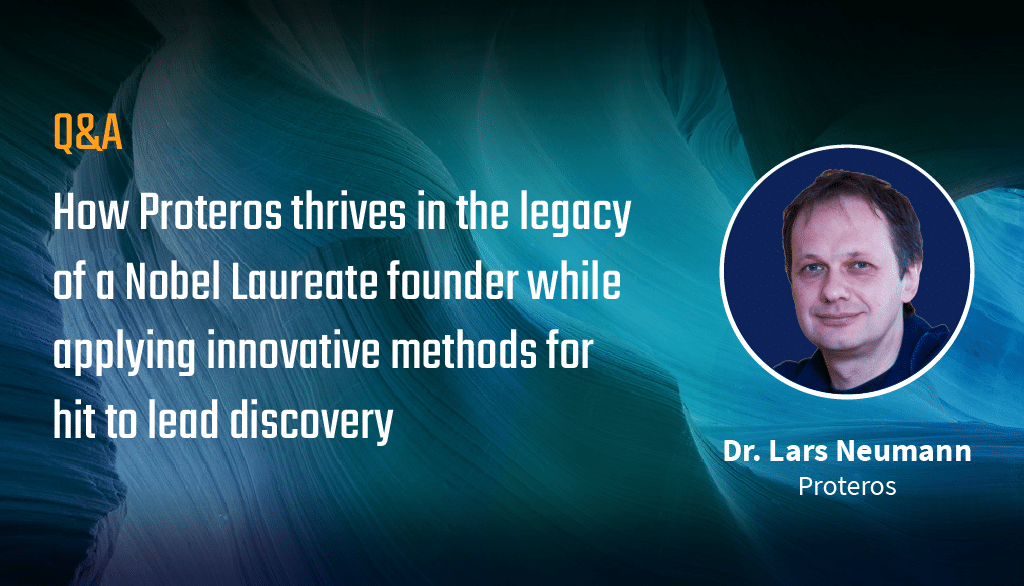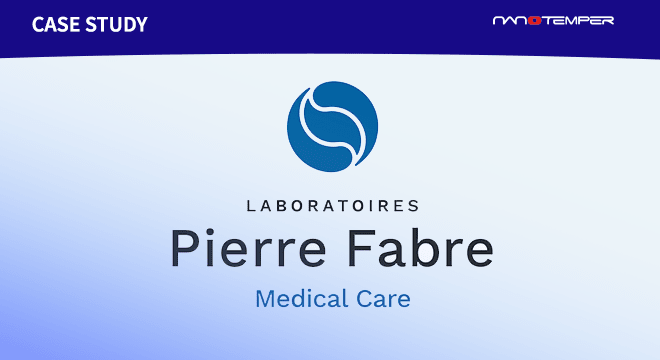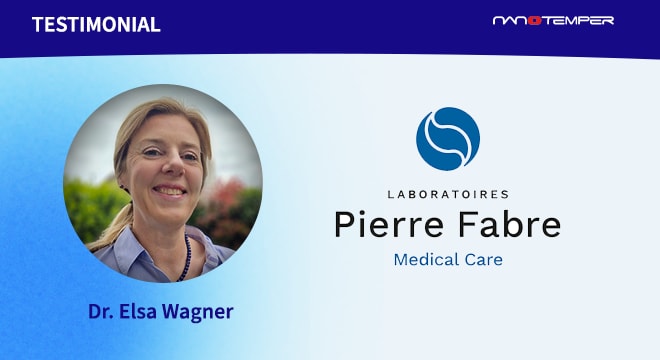
If you work for a company that’s been around for 20 years and was co-founded by a Nobel Laureate pioneer in structural biology, you’re entitled to feel proud. And there’s more to justify those feelings. Proteros, a biotech company headquartered in state-of-the-art facilities in Munich, Germany, has solved close to 400 protein structures a year and elucidated 1,200 protein-ligand structures on more than 150 different targets in just the last 4 years. Dr. Lars Neumann, Head of Assays, Biophysics & Screening shares those feelings and agreed to chat with us about how the company established itself as a partner in lead discovery and structural biology employing biophysical methods including nanoDSF and MST. Here are some interesting facts we learned when we met with him.
What challenges does Proteros solve for clients who reach out to you in search of a service provider from hit to lead discovery?
Proteros is a drug discovery services provider, supporting the screen to lead phases of more than 100 pharma and biotech clients throughout the world on multiple different targets and inhibitor modalities, in particular, challenging targets. Therefore, we require reliable, versatile, and innovative biophysical methods for library screening applications and ligand-target interaction profiling. Both nanoDSF and MST Technology and corresponding instrumentation from NanoTemper are a valuable instrumentation complementation for our portfolio of biochemical, biophysical and structural biology discovery research services.
Why is biophysical characterization important? And why should researchers care to know the Kd or stabilizing effects of ligands?
Drug activity requires drug-target binding to take place. Thus, detection of ligand-target binding is an essential step in early drug discovery. nanoDSF offers an elegant way to utilize the protein stabilizing effect by ligand binding to prove the direct interaction between a ligand and a target protein.
The Kd value describes the binding affinity of a ligand for its target. Therefore, it’s one of the main parameters that determine the required clinical drug dose and thus represents one of the most important optimization parameters in the hit to lead phase. Reliable and rapid Kd quantification is essential in drug discovery.
What’s at the top of your must-have list when incorporating new technology?
Proteros constantly expands and improves its portfolio of biochemical, biophysical and structural biology technologies in order to be able to customize screening campaigns, profiling cascades, and drug discovery strategies for each of our client’s drug discovery programs. Therefore, it is important to incorporate technologies that are applicable to a wide variety of targets and are enablers for challenging targets such as protein complexes and membrane proteins.
In order to provide innovative drug discovery services, Proteros selects technologies that produce reliable data in a time and cost-efficient manner.
How do technologies from NanoTemper Technologies compare vs. others in terms of return on your investment?
Proteros applies different biophysical binding technologies such as the high-throughput Proteros Reporter Displacement Assay (RDA), ITC, SPR, SPA, nanoDSF, and MST. nanoDSF and MST are reasonably priced for the performance from our point of view.
What made nanoDSF and MST must-have technologies?
nanoDSF is a true label-free method since it does not require any of the dyes used in traditional thermal shift assays. This potentially reduces the rates of artifacts in screening campaigns or ligand profiling activities. In addition, nanoDSF requires only a very brief assay development phase and can, therefore, be integrated into drug discovery programs very quickly.
MST represents a powerful method for biophysical screening and Kd quantification activities. Proteros uses the high sensitivity Monolith NT.115Pico instrument, which allows experiments to be conducted at very low protein concentrations. This opens drug discovery to challenging protein targets, which are difficult to produce. In addition, MST allows for quantification of Kd values in the picomolar range.
Can you give us examples of how nanoDSF is applied in current projects?
nanoDSF is a true label-free and nearly assay development free method for identifying or verifying ligand-protein binding. It is quick, cost-efficient, and can be integrated into drug discovery processes. At Proteros we use nanoDSF mainly for:
- Screen of fragment or focused libraries
- Orthogonal verification of hits derived from screens with other technologies
- Identification of allosteric binders
- Protein domain scans to identify protein regions that bind ligand
- Pre-selection of ligands for protein crystallography
What are some of your projects involving MST?
MST is an efficient method for the characterization of ligand-target interactions. At Proteros, we use it mainly to screen fragments or focused libraries, orthogonal verification of hits derived from screens with other technologies, and Kd quantification of tight binding ligands. In addition, MST enables drug discovery programs that focus on challenging, hard-to-express protein targets.
Do you have any advice for those looking for expertise in drug discovery services?
Proteros is a drug discovery service provider, supporting the screen to lead phases of more than 100 pharma and biotech clients throughout the world on multiple different targets and inhibitor modalities, in particular, challenging targets. As such, we offer services using reliable and innovative biochemical and biophysical methods for ligand-target interaction characterization such as the high-throughput Proteros Reporter Displacement Assay (RDA), ITC, SPR, SPA, enzyme assays, nanoDSF, and MST. Both nanoDSF and MST represent valuable complementation to our technology portfolio in order to customize screening campaigns, hit verification cycles and profiling strategies for each of our client’s drug discovery programs.
![]() Proteros biostructures GmbH is not affiliated with NanoTemper Technologies.
Proteros biostructures GmbH is not affiliated with NanoTemper Technologies.





















